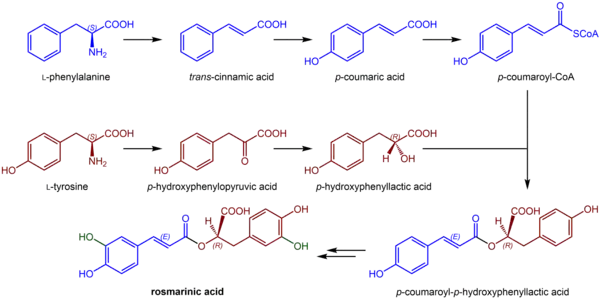ロスマリン酸
ロスマリン酸(英:Rosmarinic acid)は、ローズマリー、シソ、レモンバームなどのシソ科植物に含まれるポリフェノール類。
| ロスマリン酸 | |
|---|---|
 | |
(2R)-3-(3,4-dihydroxyphenyl)-2-{[(2E)-3-(3,4-dihydroxyphenyl)prop-2-enoyl]oxy}propanoic acid | |
| 識別情報 | |
| CAS登録番号 | 20283-92-5 |
| PubChem | 5315615 |
| ChemSpider | 4474888 |
| KEGG | C01850 |
| ChEBI | |
| ChEMBL | CHEMBL324842 |
| |
| |
| 特性 | |
| 化学式 | C18H16O8 |
| モル質量 | 360.31 g mol−1 |
| 外観 | 赤橙色の粉 |
| 融点 |
171–175 °C |
| 水への溶解度 | 難溶性 |
| 他の溶媒への溶解度 | ほとんどの有機溶媒によく溶ける[1] |
| 特記なき場合、データは常温 (25 °C)・常圧 (100 kPa) におけるものである。 | |
歴史
1958年にイタリアの化学者M. L. ScarpattiとG. Orienteによりローズマリー(Rosmarinus officinalis)より初めて単離され特定された[2]。
自然での発生
ツノゴケ、シダのシシガシラ科および単子葉・双子葉被子植物のいくつかの目の種でロスマリンの酸の蓄積が示されている[3]。
最も顕著に見られるのは多くのシソ科(シソ目の双子葉植物)、特にイヌハッカ亜科である[4]。Ocimum basilicum(バジル)、Ocimum tenuiflorum(カミメボウキ)、Melissa officinalis(レモンバーム)、Rosmarinus officinalis(ローズマリー)、Origanum majorana(マジョラム)、Salvia officinalis(セージ)、タイムおよびペパーミントなど一般的に料理用のハーブとして使われる種にみられる[5]。クズウコン属(Maranta leuconeura, Maranta depressa)やThalia (Thalia geniculata)の種などクズウコン科[3](ショウガ目の単子葉植物)の植物でも見られる[6]。
ロスマリン酸とその誘導体のロスマリン酸3′-O-β-D-グルコシドは、ツノゴケ類(Anthocerotophyta)のAnthoceros agrestisに含まれている[7]。
生合成
ロスマリン酸の生合成では、一般的なフェニルプロパノイド経路からの4-クマロイルCoAをヒロドキシシンナモイル供与体として用いる。ヒロドキシシンナモイル受容体基質はシキミ酸経路に由来する。L-チロシン由来のシキミ酸、キナ酸、3,4-ジヒドロキシフェニル酢酸[3]。よって、化学的にはロスマリン酸はコーヒー酸と3,4-ジヒドロキシフェニル酪酸のエステルであるが、生物学的には、4-クマロイル-4'-ヒドロキシフェニル酪酸から作られる[8]。ロスマリン酸シンターゼは、カフェオイルCoAと3,4-ジヒドロキシフェニル酪酸を用いてCoAとロスマリン酸を生成する酵素である。ヒドロキシフェニルピルビン酸レダクターゼもこの生合成に関わる酵素である[9]。
出典・脚注
- “Rosmarinic acid”. sigmaaldrich.com. 2013年6月30日閲覧。
- Isolamento costituzione e dell 'acido rosmarinico (dal rosmarinus off ). M. L. Scarpati, G. Oriente, Ric. Sci, 1958, volume 28, pages 2329-2333
- Evolution of rosmarinic acid biosynthesis. Petersen M, Abdullah Y, Benner J, Eberle D, Gehlen K, Hücherig S, Janiak V, Kim KH, Sander M, Weitzel C and Wolters S, Phytochemistry, Oct-Nov 2009, volume 70, issues 15-16, pages 1663-1679, doi:10.1016/j.phytochem.2009.05.010
- Distribution and taxonomic implications of some phenolics in the family Lamiaceae determined by ESR spectroscopy. J. A. Pedersen, Biochemical Systematics and Ecology, 2000, volume 28, pages 229–253
- Clifford, M.N. Chlorogenic acids and other cinnamates. Nature, occurrence and dietary burden. J. Sci. Food. Agric. (79) 362-372, 1999
- Occurrence of rosmarinic acid, chlorogenic acid and rutin in Marantaceae species. Yana Abdullah, Bernd Schneider and Maike Petersen, Phytochemistry Letters, 12 December 2008, Volume 1, Issue 4, Pages 199–203, doi:10.1016/j.phytol.2008.09.010
- Production of rosmarinic acid and a new rosmarinic acid 3′- O -β-D -glucoside in suspension cultures of the hornwort Anthoceros agrestis Paton. Katharina Vogelsang, Bernd Schneider and Maike Petersen, Planta, Volume 223, Number 2, 369-373, doi:10.1007/s00425-005-0089-8
- “MetaCyc rosmarinic acid biosynthesis I”. biocyc.org. 2020年2月閲覧。
- Two new enzymes of rosmarinic acid biosynthesis from cell cultures of Coleus blumei: hydroxyphenylpyruvate reductase and rosmarinic acid synthase. Petersen M and Alfermann AW, Z. Naturforsch. C: Biosci., 1988, volume 43, pages 501–504
- 小林彰子、[https://www.a.u-tokyo.ac.jp/pr-yayoi/61f2.pdf 食品研究からアルツハイマー病に挑む (PDF)
- 東野英明, 木下孝昭, 栗田隆 ほか、「ロスマリン酸を多く含むシソ抽出物のラットでの血糖値上昇抑制作用」 『日本食品科学工学会誌』 2011年 58巻 4号 p.164-169, doi:10.3136/nskkk.58.164
